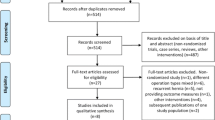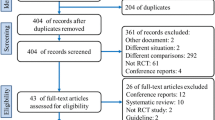Abstract
Purpose
To compare prospectively open vs. laparoscopic transabdominal preperitoneal (TAPP) inguinal hernia repair performed under different anesthetic methods.
Methods
A total of 175 patients scheduled for unilateral inguinal hernia repair were assigned to one of the following groups: (i) open repair under local anesthesia, (ii) open repair under regional anesthesia, (iii) open repair under general anesthesia, and (iv) TAPP under regional anesthesia. Immediate postoperative pain was the main outcome measured. Short- and long-term complications and the degree of patient satisfaction were also assessed.
Results
Transabdominal preperitoneal repair under regional anesthesia yielded the lowest pain scores, whereas open repair under general anesthesia yielded the highest pain scores (P < 0.05). Open repair under local or general anesthesia had a lower urinary retention incidence than the spinal groups (P < 0.05). Chronic pain incidence was lower for the TAPP group (P 0.003). There were no differences in other short- and long-term complications.
Conclusion
Transabdominal preperitoneal repair under spinal anesthesia proved superior to open repair performed under different types of anesthesia in terms of immediate (24-h) postoperative pain. The method of anesthesia might have contributed more to this favorable outcome than the surgical technique itself, but at the cost of a high urinary retention incidence. The incidence of chronic pain was lower after TAPP repair.
Similar content being viewed by others
References
McCormack K, Scott NW, Go PM, Ross S, Grant AM; EU Hernia Trialists Collaboration. Laparoscopic techniques versus open techniques for inguinal hernia repair. Cochrane Database Syst Rev. 2003;(1):CD001785.
Pokorny H, Klingler A, Schmid T, Fortelny R, Hollinsky C, Kawji R, et al. Recurrence and complications after laparoscopic versus open inguinal hernia repair: results of a prospective randomized multicenter trial. Hernia. 2008;12(4):385–9.
Liem MS, van der Graaf Y, van Steensel CJ, Boelhouwer RU, Clevers GJ, Meijer WS, et al. Comparison of conventional anterior surgery and laparoscopic surgery for inguinal-hernia repair. N Engl J Med. 1997;336(22):1541–7.
Hamza Y, Gabr E, Hammadi H, Khalil R. Four-arm randomized trial comparing laparoscopic and open hernia repairs. Int J Surg. 2010;8(1):25–8.
Wake BL, McCormack K, Fraser C, Vale L, Perez J, Grant AM. Transabdominal pre-peritoneal (TAPP) vs totally extraperitoneal (TEP) laparoscopic techniques for inguinal hernia repair. Cochrane Database Syst Rev. 2005;(1):CD004703.
McCormack K, Wake B, Perez J, Fraser C, Cook J, McIntosh E et al. Laparoscopic surgery for inguinal hernia repair: systematic review of effectiveness and economic evaluation. Health Technol Assess. 2005;9(14):1-203, iii-iv.
Perko Z, Rakić M, Pogorelić Z, Družijanić N, Kraljević J. Laparoscopic transabdominal preperitoneal approach for inguinal hernia repair: a five-year experience at a single center. Surg Today. 2011;41(2):216–21.
Zacharoulis D, Fafoulakis F, Baloyiannis I, Sioka E, Georgopoulou S, Pratsas C, et al. Laparoscopic transabdominal preperitoneal repair of inguinal hernia under spinal anesthesia: a pilot study. Am J Surg. 2009;198(3):456–9.
Sinha R, Gurwara AK, Gupta SC. Laparoscopic total extraperitoneal inguinal hernia repair under spinal anesthesia: a study of 480 patients. J Laparoendosc Adv Surg Tech A. 2008;18(5):673–7.
Ismail M, Garg P. Laparoscopic inguinal total extraperitoneal hernia repair under spinal anesthesia without mesh fixation in 1,220 hernia repairs. Hernia. 2009;13(2):115–9.
Nathan JD, Pappas TN. Inguinal hernia: an old condition with new solutions. Ann Surg. 2003;238(6 Suppl):S148–57.
Bittner R, Schwarz J. Inguinal hernia repair: current surgical techniques. Langenbecks Arch Surg. 2012;397(2):271–82.
Lau H, Wong C, Chu K, Patil NG. Endoscopic totally extraperitoneal inguinal hernioplasty under spinal anesthesia. J Laparoendosc Adv Surg Tech A. 2005;15(2):121–4.
Fierro G, Sanfilippo M, D′Andrea V, Biancari F, Zema M, Vilardi V. Transabdominal preperitoneal laparoscopic inguinal herniorrhaphy (TPLIH) under regional anaesthesia. Int Surg. 1997;82:205–7.
Athanasakis E, Saridaki Z, Kafetzakis A, Chrysos E, Prokopakis G, Vrahasotakis N, et al. Surgical repair of inguinal hernia: tension free technique with prosthetic materials (Gore-Tex Mycro Mesh expanded polytetrafluoroethylene). Am Surg. 2000;66(8):728–31.
Monaghan RA, Meban S. Expanded polytetrafluoroethylene patch in hernia repair: a review of clinical experience. Can J Surg. 1991;34(5):502–5.
Nienhuijs S, Staal E, Strobbe L, Rosman C, Groenewoud H, Bleichrodt R. Chronic pain after mesh repair of inguinal hernia: a systematic review. Am J Surg. 2007;194(3):394–400.
Aasvang E, Kehlet H. Surgical management of chronic pain after inguinal hernia repair. Br J Surg. 2005;92(7):795–801.
Bringman S, Wollert S, Osterberg J, Smedberg S, Granlund H, Heikkinen TJ. Three-year results of a randomized clinical trial of lightweight or standard polypropylene mesh in Lichtenstein repair of primary inguinal hernia. Br J Surg. 2006;93(9):1056–9.
Markar SR, Karthikesalingam A, Alam F, Tang TY, Walsh SR, Sadat U. Partially or completely absorbable versus nonabsorbable mesh repair for inguinal hernia: a systematic review and meta-analysis. Surg Laparosc Endosc Percutan Tech. 2010;20(4):213–9.
Junge K, Rosch R, Klinge U, Saklak M, Klosterhalfen B, Peiper C, et al. Titanium coating of a polypropylene mesh for hernia repair: effect on biocompatibilty. Hernia. 2005;9(2):115–9.
Koch A, Bringman S, Myrelid P, Smeds S, Kald A. Randomized clinical trial of groin hernia repair with titanium-coated lightweight mesh compared with standard polypropylene mesh. Br J Surg. 2008;95(10):1226–31.
Champault G, Bernard C, Rizk N, Polliand C. Inguinal hernia repair: the choice of prosthesis outweighs that of technique. Hernia. 2007;11(2):125–8.
Conflict of interest
We declare no conflict of interest.
Author information
Authors and Affiliations
Corresponding author
Rights and permissions
About this article
Cite this article
Symeonidis, D., Baloyiannis, I., Koukoulis, G. et al. Prospective non-randomized comparison of open versus laparoscopic transabdominal preperitoneal (TAPP) inguinal hernia repair under different anesthetic methods. Surg Today 44, 906–913 (2014). https://doi.org/10.1007/s00595-013-0805-0
Received:
Accepted:
Published:
Issue Date:
DOI: https://doi.org/10.1007/s00595-013-0805-0




